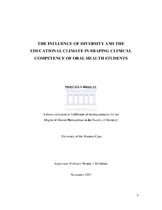| dc.description.abstract | High attrition, low retention and low throughput are major problems facing South African higher education institutions. These problems have been attributed to student under-preparedness as a result of the legacy of apartheid education provision and associated limited academic opportunities available to working-class learners. South African studies indicate that black and working-class students are less likely to perform well than their middle-class peers. In the health sciences poor academic achievement is frequently associated with poor clinical competence.
Diminished clinical competence has the potential to compromise patient treatment success. This study, therefore, set out to examine the influence of diversity, with particular reference to race and social class, and the educational climate in shaping the clinical competence of students in an oral health program at a Faculty of Dentistry in South Africa. The purpose of the study was to understand the relationship between diversity, educational climate, and clinical competence so as
to better support the learning of all students in the oral health program.
Two concepts informed the theoretical parameters of the study – diversity and educational climate. In addressing diversity, Bourdieu’s construct of economic and cultural capital provided the conceptual tools for examining the extent to which students’ race and social class locations shaped their readiness for higher education and hence influenced their experiences and performance in the program. In terms of the educational climate, Tinto’s constructs of social and academic integration, provided the lens for explicating students’ persistence in the program,
taking into account their social and academic experiences. Set in a qualitative paradigm, a case study design was used, based on its characteristic principles
of bounded place, context, time and activity. The cohort was the first-year class of 2007 in the oral health program. The students of the cohort were tracked longitudinally from 2007 to 2010. Data was gathered from a range of quantitative and qualitative sources, such as, analysis of faculty documents, observations, mark schedules, student reflective writing, focus group and individual interviews. Thematic analysis was used to analyse the data. This process involved drawing on the literature related to diversity and educational climate to identify emergent patterns and themes from the data, and then interpreting their meaning through the lenses of capital and social and academic integration. This study illuminated many ways in which student performance was affected by diversity, with particular reference to race and social class locations and associated access to economic and
cultural capital. Differences between middle-class and working-class students were noted in their performance, their preparation for university and its academic demands as well as in how these two groups of students interacted in the classroom. Significant differences were also noted in their transition and integration experiences at a social, professional and academic level. In addition, the study explicated ways in which the faculty, through its culture, structure, and pedagogy, appeared to contribute to an educational climate which either supported or deterred
student integration, both in social and academic ways. Cumulatively the challenges experienced by working-class students in particular appeared to have had real effects. The most significant effects were on their morale, their intent to engage and integrate and their consequent learning, academic performance and clinical competence. This study did not intend to solve but rather to understand the issue of differential performance. The findings of the study are envisioned to inform faculty and institutional strategies toward increasing effectiveness and responsiveness to differing student needs. | en_US |

